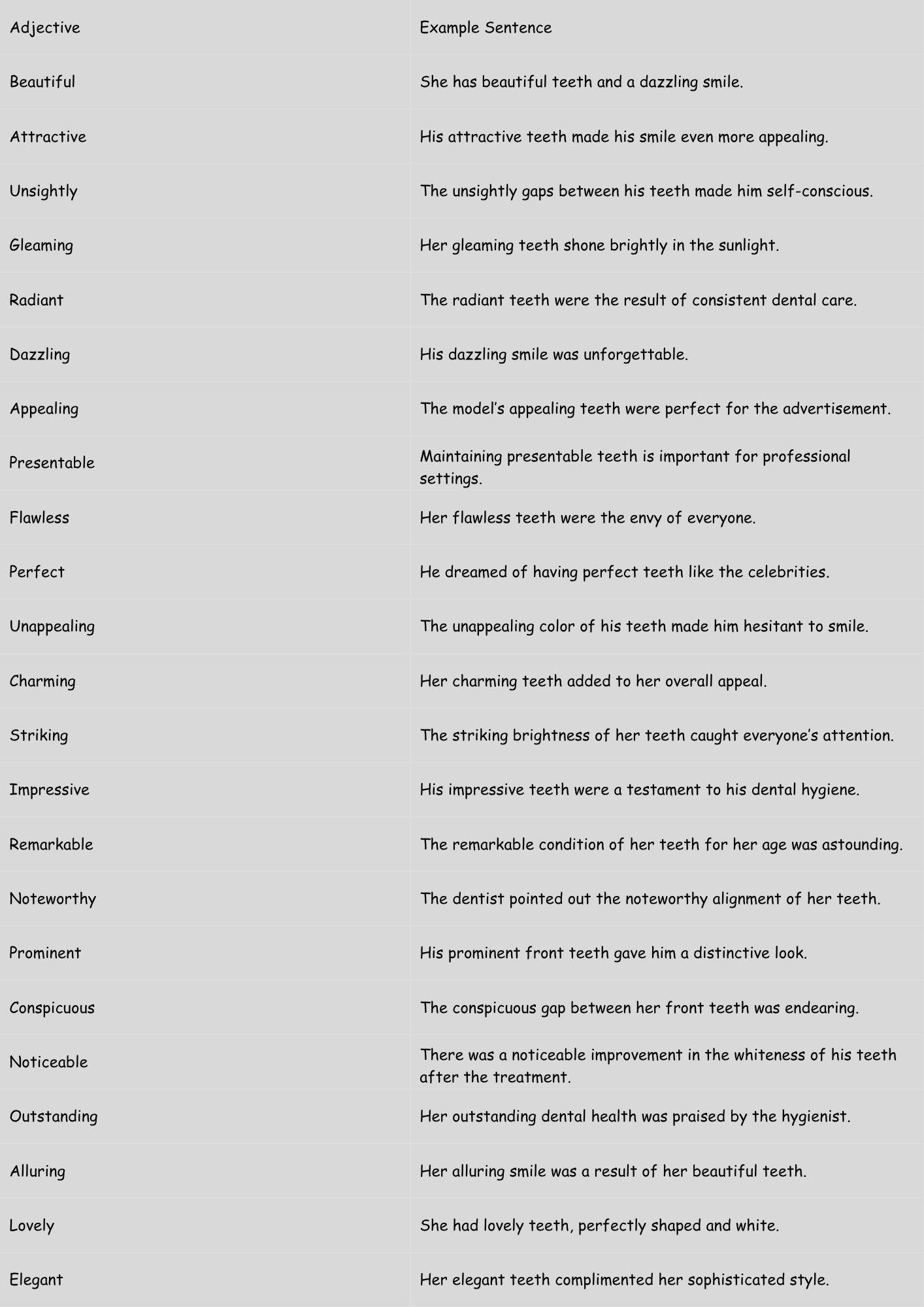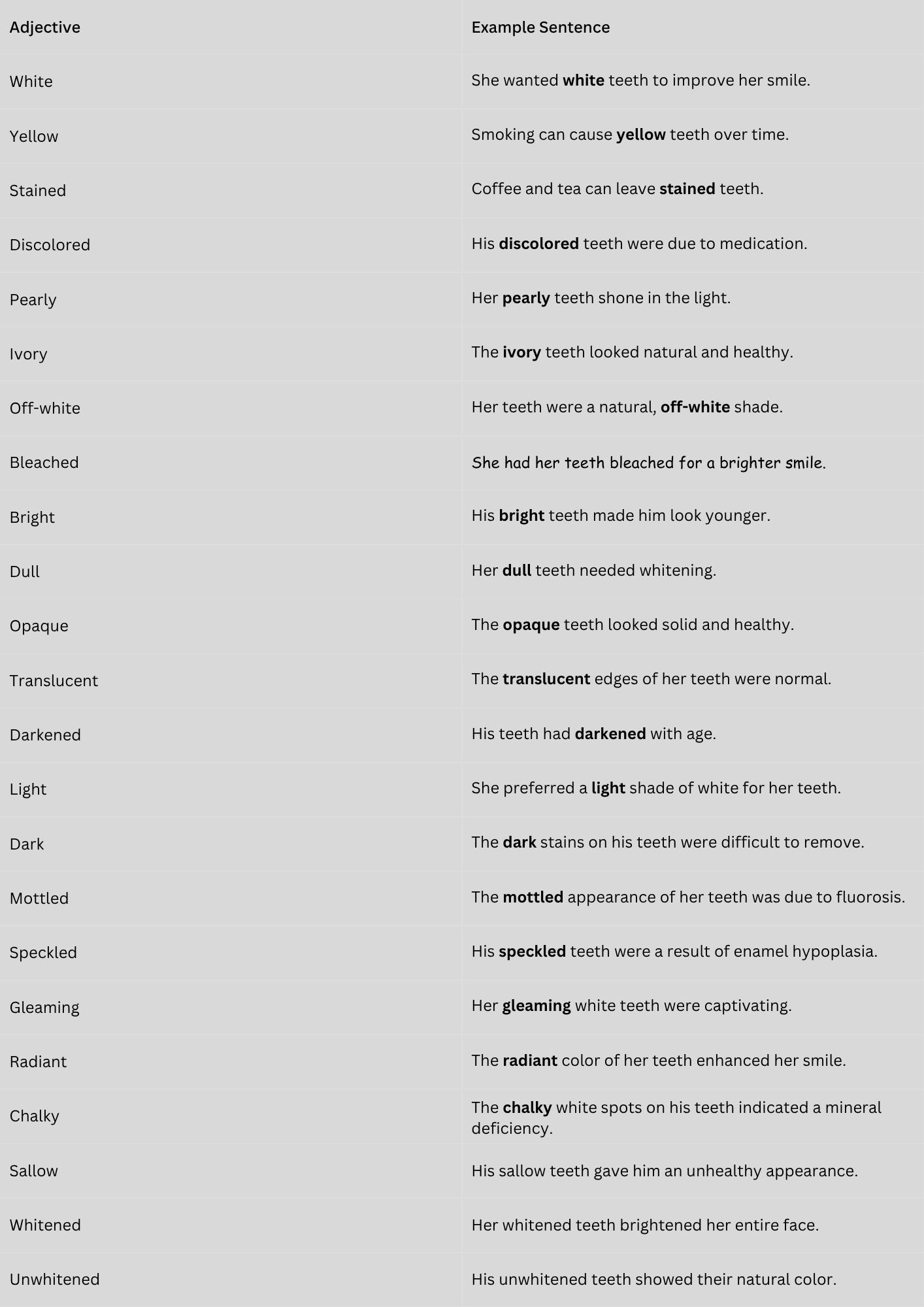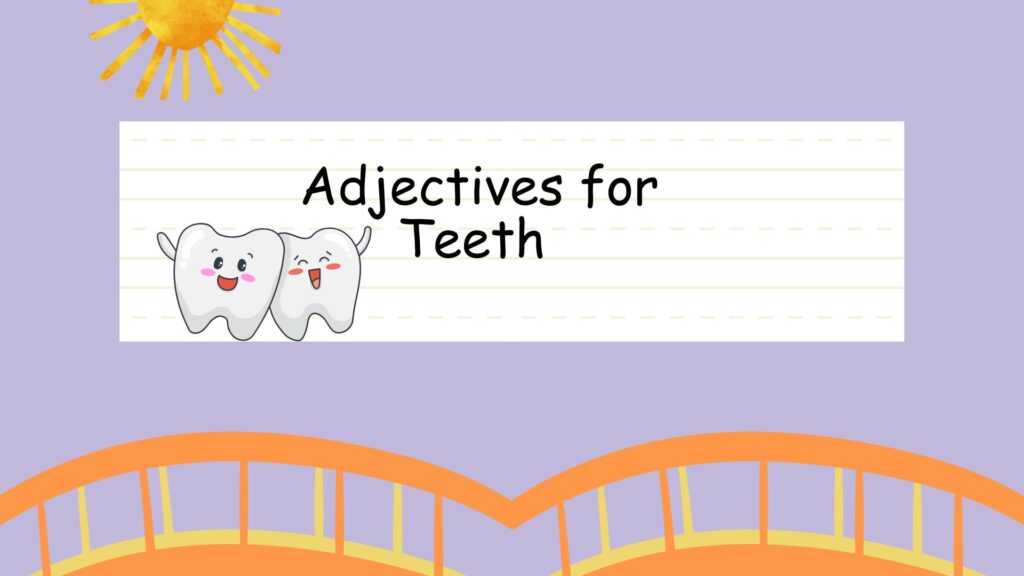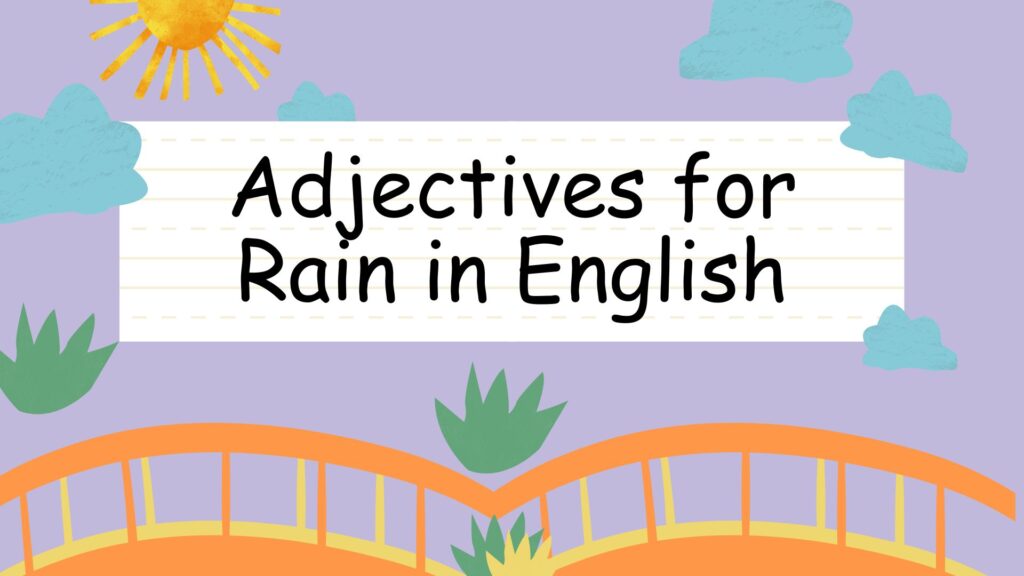Describing teeth accurately and effectively is essential in various contexts, from dental health discussions to creative writing. Choosing the right adjectives can convey precise information about their appearance, condition, and characteristics. This article provides a comprehensive guide to adjectives used to describe teeth, covering their definitions, usage, and examples. Whether you’re a student, a writer, or simply interested in improving your vocabulary, this guide will equip you with the tools to describe teeth with confidence and precision.
Understanding the nuances of these adjectives enhances communication in professional and everyday scenarios. This guide is designed to be accessible to learners of all levels, offering clear explanations and practical examples. By the end of this article, you’ll have a rich vocabulary to describe teeth in detail, improving both your written and spoken English.
Table of Contents
- Definition of Adjectives for Teeth
- Structural Breakdown
- Types of Adjectives for Teeth
- Examples of Adjectives for Teeth
- Usage Rules for Adjectives Describing Teeth
- Common Mistakes
- Practice Exercises
- Advanced Topics
- FAQ
- Conclusion
Definition of Adjectives for Teeth
Adjectives are words that describe or modify nouns. In the context of teeth, adjectives provide specific details about their qualities, such as their appearance, condition, shape, and color. They help to create a more vivid and precise picture of the teeth being described. These adjectives can be used in various settings, from dental reports to fictional narratives.
The function of adjectives is to add detail and specificity to nouns, making language more descriptive and engaging. For example, instead of simply saying “teeth,” you can use adjectives to say “white teeth,” “crooked teeth,” or “healthy teeth.” This provides a clearer and more informative description. Adjectives can also convey emotional or subjective impressions, such as “beautiful smile” or “unattractive teeth.” The choice of adjective depends on the context and the intended message.
Adjectives can be classified based on various criteria, including their meaning and function. Some adjectives are descriptive, providing factual information about the teeth. Others are evaluative, expressing an opinion or judgment. Understanding these classifications can help you choose the most appropriate adjective for a given situation.
Structural Breakdown
Adjectives typically precede the noun they modify, but they can also follow a linking verb (such as is, are, was, were, seems, appears). When adjectives precede the noun, they are known as attributive adjectives. When they follow a linking verb, they are known as predicative adjectives.
Attributive Adjectives: These appear before the noun. For example, in the phrase “yellow teeth,” the adjective “yellow” comes before the noun “teeth.” This is the most common placement for adjectives in English.
Predicative Adjectives: These appear after a linking verb. For example, in the sentence “Her teeth are straight,” the adjective “straight” follows the linking verb “are” and describes the noun “teeth.”
Adjectives can also be modified by adverbs to add further detail. For example, in the phrase “very white teeth,” the adverb “very” modifies the adjective “white,” indicating a higher degree of whiteness. The order of adjectives can also be important. Generally, opinion adjectives (e.g., beautiful) come before descriptive adjectives (e.g., white). For example, “beautiful white teeth” sounds more natural than “white beautiful teeth.”
Types of Adjectives for Teeth
Adjectives for teeth can be categorized based on the specific aspect they describe. The primary categories include adjectives describing appearance, condition, shape, and color.
Adjectives Describing Appearance
These adjectives describe the overall visual impression of the teeth. They can convey how attractive or unattractive the teeth appear.
Examples include: beautiful, attractive, unsightly, gleaming, radiant, dazzling, appealing, presentable, flawless, perfect, unappealing, charming, striking, impressive, remarkable, noteworthy, prominent, conspicuous, noticeable, outstanding.
Adjectives Describing Condition
These adjectives describe the health and state of the teeth. They indicate whether the teeth are healthy, damaged, or well-maintained.
Examples include: healthy, decayed, damaged, strong, weak, brittle, sensitive, clean, dirty, stained, well-maintained, neglected, restored, treated, untreated, sound, unsound, eroded, fragile, robust, vulnerable.
Adjectives Describing Shape
These adjectives describe the form and alignment of the teeth. They can indicate whether the teeth are straight, crooked, or evenly spaced.
Examples include: straight, crooked, aligned, misaligned, even, uneven, jagged, pointed, rounded, square, sharp, blunt, protruding, receding, gapped, crowded, symmetrical, asymmetrical, uniform, irregular, compact.
Adjectives Describing Color
These adjectives describe the shade and hue of the teeth. They indicate whether the teeth are white, yellow, or discolored.
Examples include: white, yellow, stained, discolored, pearly, ivory, off-white, bleached, bright, dull, opaque, translucent, darkened, light, dark, mottled, speckled, gleaming, radiant, chalky, sallow.
Examples of Adjectives for Teeth
The following tables provide examples of adjectives used to describe teeth, organized by category. Each table includes a variety of adjectives and example sentences to illustrate their usage.
Appearance Examples
The table below provides examples of adjectives describing the appearance of teeth, along with example sentences.
| Adjective | Example Sentence |
|---|---|
| Beautiful | She has beautiful teeth and a dazzling smile. |
| Attractive | His attractive teeth made his smile even more appealing. |
| Unsightly | The unsightly gaps between his teeth made him self-conscious. |
| Gleaming | Her gleaming teeth shone brightly in the sunlight. |
| Radiant | The radiant teeth were the result of consistent dental care. |
| Dazzling | His dazzling smile was unforgettable. |
| Appealing | The model’s appealing teeth were perfect for the advertisement. |
| Presentable | Maintaining presentable teeth is important for professional settings. |
| Flawless | Her flawless teeth were the envy of everyone. |
| Perfect | He dreamed of having perfect teeth like the celebrities. |
| Unappealing | The unappealing color of his teeth made him hesitant to smile. |
| Charming | Her charming teeth added to her overall appeal. |
| Striking | The striking brightness of her teeth caught everyone’s attention. |
| Impressive | His impressive teeth were a testament to his dental hygiene. |
| Remarkable | The remarkable condition of her teeth for her age was astounding. |
| Noteworthy | The dentist pointed out the noteworthy alignment of her teeth. |
| Prominent | His prominent front teeth gave him a distinctive look. |
| Conspicuous | The conspicuous gap between her front teeth was endearing. |
| Noticeable | There was a noticeable improvement in the whiteness of his teeth after the treatment. |
| Outstanding | Her outstanding dental health was praised by the hygienist. |
| Alluring | Her alluring smile was a result of her beautiful teeth. |
| Lovely | She had lovely teeth, perfectly shaped and white. |
| Elegant | Her elegant teeth complimented her sophisticated style. |

Condition Examples
The table below provides examples of adjectives describing the condition of teeth, along with example sentences.
| Adjective | Example Sentence |
|---|---|
| Healthy | Regular brushing helps maintain healthy teeth and gums. |
| Decayed | The dentist found several decayed teeth during the examination. |
| Damaged | His damaged teeth required extensive dental work. |
| Strong | Strong teeth are essential for chewing food properly. |
| Weak | Her weak teeth were prone to chipping and cracking. |
| Brittle | The elderly patient had brittle teeth due to calcium deficiency. |
| Sensitive | He experienced pain due to his sensitive teeth. |
| Clean | She always makes sure to have clean teeth before going out. |
| Dirty | The dentist warned him about the buildup on his dirty teeth. |
| Stained | Coffee and tea can cause stained teeth over time. |
| Well-maintained | Her well-maintained teeth were a result of regular dental visits. |
| Neglected | His neglected teeth showed signs of severe decay. |
| Restored | The restored teeth looked as good as new after the treatment. |
| Treated | Her treated teeth were now free from pain and sensitivity. |
| Untreated | His untreated teeth continued to worsen over time. |
| Sound | The dentist confirmed that all her teeth were sound and healthy. |
| Unsound | The unsound tooth needed to be extracted to prevent further infection. |
| Eroded | Acidic foods can cause eroded teeth enamel. |
| Fragile | The fragile teeth were easily susceptible to damage. |
| Robust | His robust teeth allowed him to enjoy a variety of foods. |
| Vulnerable | Her teeth were vulnerable to decay due to poor oral hygiene. |
| Cared-for | Her cared-for teeth were a testament to her diligent oral hygiene routine. |
| Uncared-for | His uncared-for teeth were covered in plaque and tartar. |
Shape Examples
The table below provides examples of adjectives describing the shape of teeth, along with example sentences.
| Adjective | Example Sentence |
|---|---|
| Straight | Braces can help align straight teeth for a perfect smile. |
| Crooked | His crooked teeth were a result of genetics and childhood habits. |
| Aligned | Her aligned teeth were the result of orthodontic treatment. |
| Misaligned | His misaligned teeth caused difficulty in chewing. |
| Even | The dentist admired her even teeth arrangement. |
| Uneven | His uneven teeth made him self-conscious about his smile. |
| Jagged | The jagged edges of the broken tooth were quite painful. |
| Pointed | Some people have naturally pointed canine teeth. |
| Rounded | Her rounded teeth gave her a soft, friendly appearance. |
| Square | His square teeth were a distinctive feature. |
| Sharp | The sharp incisors were perfect for biting into food. |
| Blunt | The blunt molars were designed for grinding food. |
| Protruding | His protruding front teeth were corrected with braces. |
| Receding | Her receding teeth made her jawline appear less defined. |
| Gapped | The gapped teeth gave her smile a unique character. |
| Crowded | Her crowded teeth required orthodontic intervention. |
| Symmetrical | The symmetrical arrangement of her teeth was aesthetically pleasing. |
| Asymmetrical | The slightly asymmetrical teeth gave his face character. |
| Uniform | The uniform size and shape of her teeth were striking. |
| Irregular | The irregular pattern of his teeth was due to a genetic condition. |
| Compact | Her compact teeth fit perfectly within her small mouth. |
| Well-spaced | Her well-spaced teeth allowed for easy cleaning. |
| Overlapping | His overlapping teeth were a result of overcrowding. |
Color Examples
The table below provides examples of adjectives describing the color of teeth, along with example sentences.
| Adjective | Example Sentence |
|---|---|
| White | She wanted white teeth to improve her smile. |
| Yellow | Smoking can cause yellow teeth over time. |
| Stained | Coffee and tea can leave stained teeth. |
| Discolored | His discolored teeth were due to medication. |
| Pearly | Her pearly teeth shone in the light. |
| Ivory | The ivory teeth looked natural and healthy. |
| Off-white | Her teeth were a natural, off-white shade. |
| Bleached | She had her teeth bleached for a brighter smile. |
| Bright | His bright teeth made him look younger. |
| Dull | Her dull teeth needed whitening. |
| Opaque | The opaque teeth looked solid and healthy. |
| Translucent | The translucent edges of her teeth were normal. |
| Darkened | His teeth had darkened with age. |
| Light | She preferred a light shade of white for her teeth. |
| Dark | The dark stains on his teeth were difficult to remove. |
| Mottled | The mottled appearance of her teeth was due to fluorosis. |
| Speckled | His speckled teeth were a result of enamel hypoplasia. |
| Gleaming | Her gleaming white teeth were captivating. |
| Radiant | The radiant color of her teeth enhanced her smile. |
| Chalky | The chalky white spots on his teeth indicated a mineral deficiency. |
| Sallow | His sallow teeth gave him an unhealthy appearance. |
| Whitened | Her whitened teeth brightened her entire face. |
| Unwhitened | His unwhitened teeth showed their natural color. |

Usage Rules for Adjectives Describing Teeth
When using adjectives to describe teeth, it’s important to follow certain rules to ensure clarity and accuracy. These rules include adjective order, the use of commas, and the correct placement of adjectives in relation to the noun.
Adjective Order: When using multiple adjectives, follow the general order: opinion, size, physical quality, shape, age, color, origin, material, and type. For example, “beautiful white teeth” (opinion then color).
Commas: Use commas to separate coordinate adjectives, which are adjectives that independently modify the noun. For example, “clean, straight teeth.” However, do not use a comma if the adjectives are cumulative, meaning one adjective modifies the other. For example, “bright white teeth” (bright modifies white, which modifies teeth).
Placement: Adjectives usually come before the noun they modify (attributive position). However, they can also follow a linking verb (predicative position). For example, “Her teeth are white” (predicative) vs. “She has white teeth” (attributive).
Exceptions: Some adjectives have specific connotations and should be used carefully. For example, “false teeth” is a common term for dentures, while “artificial teeth” is less common but still acceptable. Be mindful of the context and the intended meaning.
Common Mistakes
Several common mistakes occur when using adjectives to describe teeth. Understanding these errors can help you avoid them and improve your accuracy.
Incorrect Adjective Order: Placing adjectives in the wrong order can sound awkward. For example, saying “white beautiful teeth” instead of “beautiful white teeth.”
Misusing Commas: Incorrectly using or omitting commas between adjectives can create confusion. For example, “clean straight teeth” (missing comma) vs. “clean, straight teeth” (correctly using a comma because they are coordinate adjectives).
Using Vague Adjectives: Using overly general adjectives that don’t provide specific information. For example, saying “nice teeth” instead of “white, straight teeth.”
Confusing Similar Adjectives: Confusing adjectives with similar meanings but different connotations. For example, using “gleaming” when “white” would be more appropriate.
Incorrect Examples:
| Incorrect | Correct | Explanation |
|---|---|---|
| White beautiful teeth | Beautiful white teeth | Adjective order is incorrect. Opinion adjectives come before descriptive adjectives. |
| Clean straight teeth | Clean, straight teeth | Missing comma between coordinate adjectives. |
| Nice teeth | Healthy, white teeth | “Nice” is too vague. More specific adjectives provide better description. |
| Gleaming teeth covered in plaque. | Dirty teeth covered in plaque. | “Gleaming” implies cleanliness and brightness, which contradicts the presence of plaque. |
Practice Exercises
Test your understanding of adjectives for teeth with these practice exercises. Choose the best adjective to complete each sentence.
Exercise 1: Fill in the Blanks
| Question | Answer |
|---|---|
| 1. She has ________ teeth and a radiant smile. | beautiful |
| 2. The dentist found several ________ teeth during the examination. | decayed |
| 3. Braces can help align ________ teeth for a perfect smile. | straight |
| 4. Smoking can cause ________ teeth over time. | yellow |
| 5. His ________ teeth required extensive dental work. | damaged |
| 6. She always makes sure to have ________ teeth before going out. | clean |
| 7. The elderly patient had ________ teeth due to calcium deficiency. | brittle |
| 8. Coffee and tea can leave ________ teeth. | stained |
| 9. He experienced pain due to his ________ teeth. | sensitive |
| 10. The ________ edges of the broken tooth were quite painful. | jagged |
Exercise 2: Correct the Sentence
Rewrite the following sentences using more appropriate adjectives.
| Question | Answer |
|---|---|
| 1. He has nice teeth. | He has healthy, white teeth. |
| 2. Her teeth are okay. | Her teeth are well-maintained and strong. |
| 3. His teeth are bad. | His teeth are decayed and neglected. |
| 4. She has teeth. | She has beautiful, straight teeth. |
| 5. His teeth are alright. | His teeth are clean and aligned. |
| 6. The teeth are not good. | The teeth are unsound and eroded. |
| 7. The teeth are fine. | The teeth are robust and healthy. |
| 8. The teeth are so-so. | The teeth are discolored and uneven. |
| 9. Those are teeth. | Those are gleaming, radiant teeth. |
| 10. His teeth were something. | His teeth were noticeably misaligned. |
Advanced Topics
For advanced learners, it’s important to understand more complex aspects of using adjectives for teeth. This includes understanding the nuances of figurative language, using adjectives in specialized contexts, and recognizing regional variations in vocabulary.
Figurative Language: Adjectives can be used metaphorically or figuratively to describe teeth. For example, “pearl-like teeth” uses the adjective “pearl-like” to create a vivid image of the teeth’s appearance. This adds depth and creativity to the description.
Specialized Contexts: In dentistry, specific adjectives are used to describe dental conditions, such as “impacted” (to describe a tooth that is blocked from erupting) or “carious” (to describe a tooth affected by decay). Understanding these terms is essential for professionals in the field.
Regional Variations: Some regions may have unique adjectives or expressions for describing teeth. Being aware of these variations can help you communicate more effectively with people from different backgrounds. For example, a term common in one English-speaking country may be less common or unknown in another.
FAQ
Here are some frequently asked questions about using adjectives for teeth.
1. What is the correct order of adjectives when describing teeth?
The general order is opinion, size, physical quality, shape, age, color, origin, material, and type. For example, “beautiful white teeth.”
2. How do I know when to use a comma between adjectives?
Use a comma between coordinate adjectives, which independently modify the noun. For example, “clean, straight teeth.” Do not use a comma if the adjectives are cumulative, meaning one adjective modifies the other. For example, “bright white teeth.”
3. What are some common mistakes to avoid when using adjectives for teeth?
Avoid incorrect adjective order, misusing commas, using vague adjectives, and confusing similar adjectives.
4. How can I improve my vocabulary for describing teeth?
Read widely, pay attention to how adjectives are used in context, and practice using new adjectives in your own writing and speaking.
5. Are there any adjectives that should be avoided when describing teeth?
Avoid using adjectives that are overly judgmental or offensive. Focus on providing objective and descriptive information.
6. How do I describe teeth that have both good and bad qualities?
Use a combination of adjectives to accurately reflect the teeth’s condition. For example, “mostly straight but slightly stained teeth.”
7. What is the difference between “false teeth” and “artificial teeth”?
“False teeth” is a more common and idiomatic term for dentures. “Artificial teeth” is also acceptable but less frequently used.
8. How can I use adjectives to describe teeth in a creative or imaginative way?
Use figurative language, such as metaphors and similes, to create vivid images. For example, “pearl-like teeth” or “teeth as white as snow.”
Conclusion
Mastering the use of adjectives for teeth enhances your ability to communicate effectively and accurately. By understanding the different types of adjectives and following the usage rules, you can describe teeth with precision and clarity. Avoiding common mistakes and practicing regularly will further improve your skills. Whether you’re writing a dental report, crafting a fictional narrative, or simply engaging in everyday conversation, a rich vocabulary of adjectives will enable you to express yourself with confidence.
Continue to expand your knowledge by reading widely and paying attention to how adjectives are used in various contexts. Practice using new adjectives in your own writing and speaking. With dedication and effort, you can become proficient in using adjectives to describe teeth, enriching your language skills and improving your overall communication.



